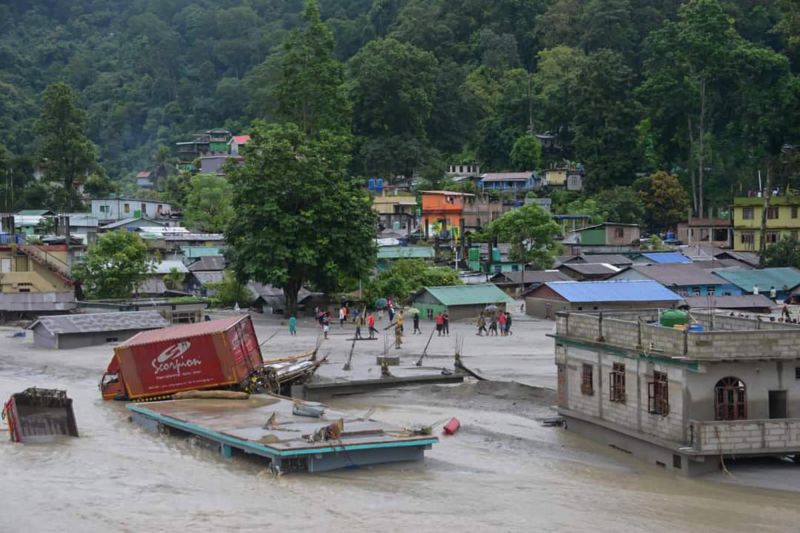
A Tragic Disaster Unfolds: Indian Himalayas Devastated by Flash Floods, Leaving 74 Dead and Over 100 Missing

Flash floods in the Indian Himalayas have claimed 74 lives, with over 100 individuals still reported missing The death toll continues to rise after a glacial lake overflowed, causing this devastating calamity
The death toll resulting from flash floods triggered by a glacial lake overflow in the Himalayas of India has risen to 74 as of Monday. Provincial officials report that 101 individuals remain missing, days after the disaster occurred. After heavy rainfall in the northeastern state of Sikkim, the excessive water gushed through narrow river valleys from Lohnak Lake in the northern region of the state. This event caused significant damage to a dam and resulted in widespread destruction in villages and Rangpo town, located approximately 50 km (30 miles) south of the state capital, Gangtok.
Rescue teams have discovered 25 remains in the region, while an additional eight bodies of army personnel were found in the nearby state of West Bengal, according to Vijay Bhushan Pathak, the chief secretary of Sikkim. He informed Reuters that there are currently 101 individuals who are still unaccounted for in the Himalayan region, which has experienced a sequence of severe weather conditions resulting in various natural disasters. Among the missing are fourteen army personnel, as stated in a release from the defense ministry.
The aftermath of one of the most severe calamities in the remote region in over five decades posed immense challenges for the search and rescue mission. Damaged roads, scarce communication, and inclement weather hindered efforts to locate survivors, while residents toiled relentlessly to remove sludge and debris.
Members of Indian Army try to recover buried trucks in Sikkim on October 5, 2023.
Indian Army/Handout/Reuters
A vehicle lies on top of a submerged building after flash floods triggered by a sudden heavy rainfall swamped the Rangpo town in Sikkim, India, Oct. 5, 2023.
Prakash Adhikari/AP
Parveen Shama, the top district official of Jalpaiguri in West Bengal, said 41 bodies were found in the district.
In the first five days of October, Sikkim, a Buddhist state with a population of 650,000, located between Nepal, Bhutan, and China, experienced an unusually high amount of rainfall, measuring 101 millimeters (four inches), which was more than double the average. Resting at the base of a melting glacier, Lhonak Lake is a significant glacial water body with a distinctive bullet shape.
More than 60% of the water in the lake was drained following an intense rainstorm that triggered a glacial lake outburst. This occurrence takes place when a glacial lake overflows due to excessive water or when the land or ice surrounding the lake collapses, resulting in a sudden rush of water and debris down the mountains.
Lhonak Lake has been extensively researched by scientists who have consistently identified it as one of the swiftest growing glacial lakes in the area, posing a significant threat of a potential glacial outburst, as indicated by various studies.
A woman holds a child inside a relief shelter after flash floods, caused by a lake burst in Singtam, Sikkim, India, October 8, 2023.
Francis Mascarenhas/Reuters
A man walks next to a vehicle buried in mud due to floods, in Teesta Bazaar, Kalimpong District, West Bengal, India October 7, 2023.
Birat Rai/Reuters
Mukesh Kumar, a 43-year-old migrant worker residing in Rangpo, recounted the harrowing experience of narrowly escaping the devastating flash flood. He emphasized that had he and his neighbors delayed for just two more minutes, they could have tragically lost their lives. Gazing at the aftermath of the flood, Kumar observed the wreckage and filth that now engulfed his accommodation.
Residents told Reuters that many people whose dwellings were on the ground floor could not have survived.
Baiju Sharma, 45, who ran a furniture business, surveyed the aftermath of the disaster.
Sharma indicated his neighbor's house, stating that the current location is now elevated by 15 feet (4.5 meters) compared to before.
According to government officials, approximately 2,000 stranded tourists in inaccessible regions of northern Sikkim have been confirmed safe. The state authorities and the army have ensured that these individuals have access to food and communication facilities in order to stay in touch with their families.
The Himalayan region, often referred to as the rooftop of the world, is environmentally fragile and susceptible to flash floods, landslides, and regular instances of flooding in Sikkim. Scientific consensus confirms that the frequency and intensity of extreme weather events are rapidly increasing due to the accelerating climate crisis caused by human activities.
CNNs Helen Regan, Akanksha Sharma and Sania Farooqui contributed reporting










